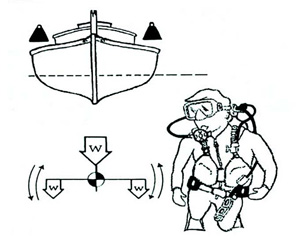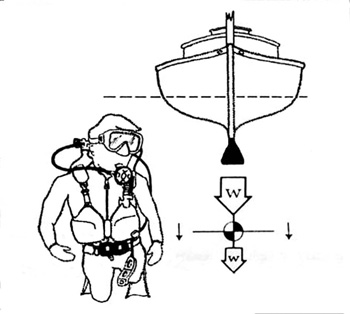Moving Your WeightsContents of this Issue: A Guide to the Coral Reefs of the Caribbean Editorial Office: Ben Davison Publisher and Editor Undercurrent 3020 Bridgeway, Suite 102 Sausalito, CA 94965 — from your love handles to your navel from the February, 2005 issue of Undercurrent
Thanks to the weight carried in their keels, sailboats are extremely stable. Divers ought to pay attention. With tanks up and bellies down, many divers struggle to remain horizontal, particularly at the beginning of the dive when tanks are full of air and weigh 6 pounds or so more than they do at the end of the dive. Turn slightly, and sidemounted weights and shifting tanks start you rotating. Relax too much, and you may gravitate to the classic turtle-on-hisback position. Why carry weight on your rails rather than your keel? Why waste air and energy maintaining stability? Rid yourself of your lead love handles and stash your weight on your keel, as if you were a sailboat. Place as much of your weight over or next to your navel as possible. It provides amazing stability, and the ladies will love it, because their weights will not even be touching their bodies through most of the dive. Men might wonder why this will matter to women and not to them, but men do not have those protruding and sensitive pelvic bones that are so often bruised by weights during a week of diving. I’ve made well over 20,000 dives this way and introduced the technique to nearly all my guests over the past 30 years. Most returning guests report that they far prefer this simple system, and they are fascinated by how many divemasters try to “help them” by pointing out that their weight belt is “set up wrong.” To rig the belt, place all your weight close together, about three inches from the buckle. (If you place the weight closest to the buckle closer than this, the weight itself may open the buckle.) If you have a very small waist and/or are carrying a lot of weight, you can in fact “stack” your weights one on top of the other to end up with an even greater concentration of “weight at the right place.”
When you put on the belt, center the weight over your navel and place the buckle to the right side so you don’t confuse it with your BC buckle. This will facilitate a right-hand release. When you release a weight belt rigged this way, it drops freely without the weights getting caught in the BC or tank. Carry two weight-keepers in your travel kit, so you can put them on your rented belt. Or insert the belt through the first slit in the weight, make a half turn, then run the belt back through. That twist will secure the weight on the belt so it won’t slide. If you have a particularly small or large waist, carry your own personal weight belt with you (without the lead, of course). After you’ve descended several feet, tighten your belt so it won’t sag like saddle bags or spin around you. Even if you do not bother to tighten the belt, it will usually remain in position anyway since all of the weight is in one location.
The only drawback: putting on the weight belt is slightly more cumbersome, a negligible price to pay for a more stable and comfortable dive. — The author of this article, Fred Good, established St. George’s Lodge in Belize in 1980, and now manages it for new owners. |

I want to get all the stories! Tell me how I can become an Undercurrent Online Member and get online access to all the articles of Undercurrent as well as thousands of first hand reports on dive operations world-wide
| Home | Online Members Area | My Account |
Login
|
Join
|
| Travel Index |
Dive Resort & Liveaboard Reviews
|
Featured Reports
|
Recent
Issues
|
Back Issues
|
|
Dive Gear
Index
|
Health/Safety Index
|
Environment & Misc.
Index
|
Seasonal Planner
|
Blogs
|
Free Articles
|
Book Picks
|
News
|
|
Special Offers
|
RSS
|
FAQ
|
About Us
|
Contact Us
|
Links
|
3020 Bridgeway, Ste 102, Sausalito, Ca 94965
All rights reserved.



